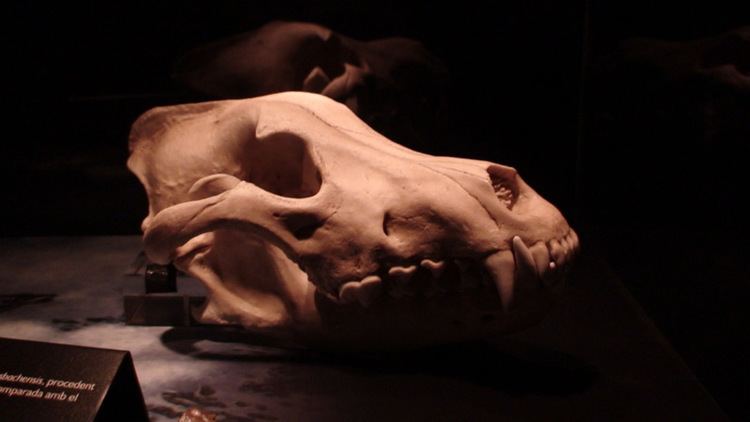Kingdom Animalia Class Mammalia Family Canidae Rank Subspecies | Phylum Chordata Order Carnivora Genus Canis | |
 | ||
Similar Canis lepophagus, Canis falconeri, Canis edwardii, Armbruster's wolf, Eucyon | ||
Canis variabilis, sometimes known as the Zhoukoudian wolf, is an extinct small wolf that once inhabited parts of what is now present-day China and Yakutia. It is notable for its cranio-dental characteristics that have led some paleontologists to propose a distant relationship to the domestic dog.
Contents
Discovery
The wolf's fossils were found at the Zhoukoudian (once spelt Choukoutien) cave system and archaeological site in 1934 and named by its discoverer, Pei Wenzhong.
Although no sharp line can be traced between the above described Canis and a true C. lupus, the marked differences found in size, and in cranial characters, seem to be sufficient for creating, at least, a new variety, Canis lupus variabilis, for the Zhoukoudian Locality 1 small wolf.
The small wolf was initially named Canis lupus variabilis but was later recognised as a variant of Canis variabilis (Pei 1934) that was also discovered and named by Pei in the same year. Pei stated that the Nihewan wolves attributed to Canis chihliens should also be included in this new category. Canis variabilis was also known from Lantian County in Shaanxi Province, so it had a wide range in time and space.
At the site, the small wolf's remains were in close proximity to Homo erectus pekinensis or Peking man, in layers dating back to 500,000-200,000 years before present (YBP).
Distribution
Although discovered in China, fossil remains of C. variabilis have been discovered in central Yakutia in Siberia on the Alaseya River and the Aldan River. They are the oldest recorded samples of Olesky fauna found in Yakutia. Canis cf. variabilis (where cf. in Latin means confer, uncertain) is thought to have been widespread in Eurasia until around 300,000 YBP and does not appear to overlap with the earliest occurrence of the morphologically distinctive gray wolf.
Relationship to the domestic dog and the modern wolf
Pei describes this small wolf as exhibiting variation in size and tooth adaptations, stating that it's skull differs from the typical wolf in much smaller size (about 175.0 mm total length for a large C. variabilis specimen), with a more slender muzzle and noticeably reduced or absent sagittal crest. In addition, the lower border of some C. variabilis mandibles is "strongly convex as in the dog". The one trait aligning C. variabilis with wolves is relatively large carnassial teeth (P1 20.4 – 23.0 mm; M1 22.0 – 24 mm). A later researcher has confirmed Pei's measurements, and describes the wolf's skull as having "heavy, wolf-like proportions although smaller than any extant C. lupus. More recent researchers have revisited Pei's view that the ancestor of the dog is a now extinct Canis lupus, and proposed that C. variabilis might be an ancestor of the dog lineage.
In 2012, a study of the wolf-like Canis species of ancient China conducted by the noted vertebrate paleontologist and geologist Xiaoming Wang found that C. variabilis was "very strange" compared to other Canis in China as it had much smaller cranio-dental dimensions than earlier and later species. The study concluded that "It is very likely that this species is the ancestor of the domestic dog Canis familiaris, a hypothesis that has been proposed by previous authors."
In 2015, a mitochondrial DNA analysis was conducted on 14 ancient canid remains from Arctic Siberia and suggested a genetic contribution from wolves of that region, including possibly Canis cf. variabilis, to the dog and modern wolf lineages. This was the first study to extract DNA material from C. variabilis.
Canis mosbachensis
Canis mosbachensis was a wolf that once lived across Eurasia before going extinct. It was smaller than most North American wolf populations and smaller than Canis rufus, and has been described as being similar in size to Canis papilles. It has been proposed that C. mosbachensis invaded North America where it became isolated by the later glaciation and there gave rise to C. rufus. As wolves continue to evolve they become bigger. In Europe during the Rancholabrean period of North America, Canis mosbachensis began increasing in size. It is proposed that in Eurasia, C. mosbachensis evolved into C. lupus, from where it also invaded North America.
In 2010, a study found that the diversity of the Canis group decreased by the end of the Early Pleistocene to Middle Pleistocene and was limited to the small wolves of the Canis mosbachensis–Canis variabilis group and the large hypercarnivorous Canis (Xenocyon) lycaonoides in Eurasia. The true gray wolves made their appearance at the end of the Middle Pleistocene at about 0.5–0.3 million YBP. Based on morphology, Canis mosbachensis has been proposed as the ancestor of the Canis lupus lineage. Based on genetics, Canis variabilis has been proposed as contributing to the wolf/dog lineage. The two small wolves, Canis variabilis and Canis mosbachensis, are contemporaries in mid-latitude Eurasia and are similar in morphology, with phylogenetic analysis showing them to group together in a common region on a cladogram and they could represent one geographically-widespread mid-Pleistocene wolf.
